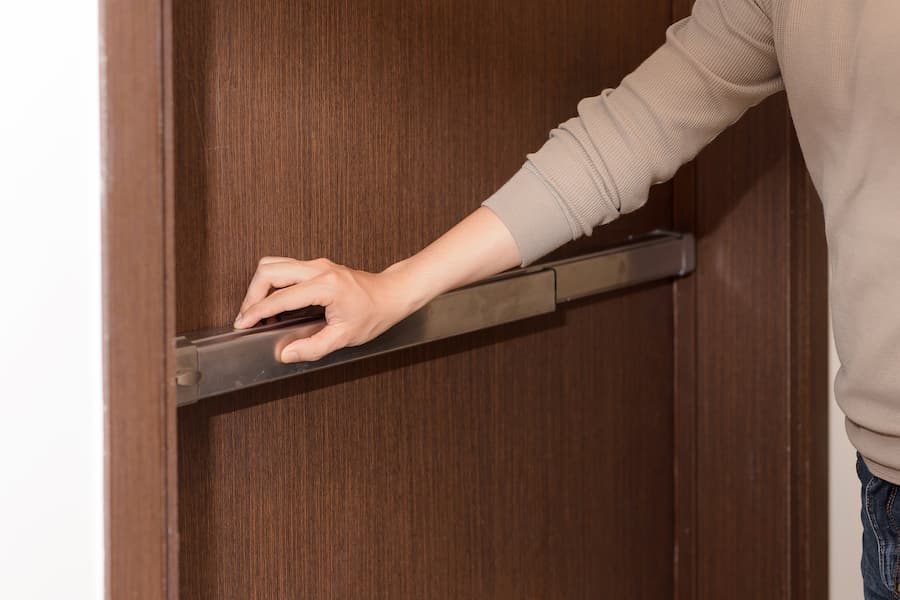
When you see an exit door, do you wonder how do you adjust a panic bar?
Tragedies throughout history have taught us the importance of providing a quick and easy exit for people during emergencies.
Panic bars ensure that people can quickly exit buildings whenever the need arises.
How do panic bars work?
Panic bars are installed on commercial doors and fire doors, allowing people fast and easy egress. The panic bars unlock an exit door from the inside without the need for any keys, pushing down the bar to unlock the door.
The spring-loaded crossbar is fixed horizontally on the inside of the exit door. It makes it easy for people to see the device and use it to open the door outward.
What are the specifications for panic bars?
Panic bars and exit doors must meet specifications outlined by local building codes.
Here are some of the main specifications for panic bars:
- The crossbar or touchpad part of the panic bar must be at least half the width of each door. If the building has balanced doors, that is, doors where the pivot point is closer to the door’s center, a push-pad panic device must be installed. The device must not be more than half the width of the door.
- The panic bar must be mounted at least 34 to 48 inches above the floor of the building.
- Doors that have panic bars installed must not have any other locking device, such as chains or padlocks. It is a necessary requirement for safety purposes, as nothing should keep people from opening the doors in case of emergencies.
- A panic bar should not require more than 15 pounds of force to unlock it.
- The panic bar hardware must comply with ADA standards. It is to make sure that even those with disabilities can easily egress during an emergency.
- Panic hardware must be installed with controlled egress and delayed egress exit points.
- You must only use fire-certified panic bars installation on fire doors.
- In some states, it may be mandatory to test the panic bars for resistance in case of hurricanes and tornadoes.

What are the different types of panic bars available?
The traditional horizontal panic bar is most commonly used in commercial buildings. However, there are other types of panic bars available as well.
Vertical rod panic bars
They look similar to horizontal panic bars but vertical rod panic bars have locking and unlocking mechanisms at the top and bottom of the door. These mechanisms are activated when the hardware is pressed, unlike in a conventional horizontal panic bar.
Concealed vertical rod panic bars
Concealed vertical rod panic bars are ideal for aluminum and other hollow body doors. These panic bars have special rods that accommodate the hollow body of these exit doors. The hardware is installed internally, minimizing the risk of intruders using your exit doors as entryways.
Panic bar levers
Panic bar levers are integrated components of panic bars and are placed on the exterior of your exit doors. These can serve as a backup option for entry in emergency scenarios, allowing firefighters or rescuers to free people inside the buildings. It also provides easy access to rescue teams that are responding to emergency calls.

How do you adjust a panic bar?
Panic bars may be installed onto single doors, double doors, double egress doors, and a pair of doors with a center mullion.
If you are using a single door, the most common panic bar uses a rim exit device. For double doors, the most common exit application uses one rim and one vertical rod panic bar. The active door has the rim exit device, while the other has the vertical rod panic bar.
For double egress doors, two surface-mounted vertical rod panic bars are most commonly used.
When installing or adjusting the panic bars, it is important to adhere to the local building codes.
We are your local emergency locksmith company. If you are unsure of how do you adjust a panic bar, call Speedy Locksmith today.
Mobile Locksmith Service Areas
- Mobile Locksmith Merriam
- Mobile Locksmith, Prairie Village
- Mobile Locksmith, Olathe
- Mobile Locksmith, Leawood, Kansas
- Mobile Locksmith, Overland Park
- Mobile Locksmith, Lenexa
- Mobile Locksmith, Shawnee
- Mobile Locksmith, Mission
- Mobile Locksmith, Kansas City, KS
- Mobile Locksmith, Kansas City, Missouri
